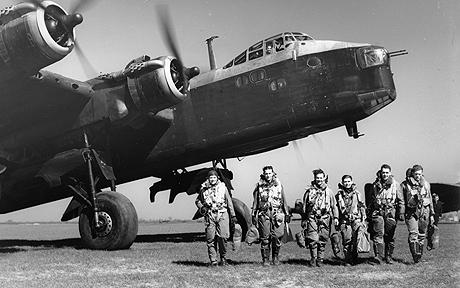The 7 Sqdn left from Oakington at 1942-04-28 at 21:33. Loc or duty Gardening
He flew with a Short Stirling (type I, serial N3727, code MG-G).
Campaign report of the USAAF:
(8th Air Force): Advanced echelon (ADVON) of HQ 8th Air Force and bomber, interceptor and base commands, along with 15th Bombardment Squadron (Light), 2d Air Depot Group, and a weather detachment totalling about 1,800 men, sail from Boston, Massachusetts for the UK.
Campaign report of the RAF:
27/28 April 1942
Cologne
97 aircraft - 76 Wellingtons, 19 Stirlings, 2 Halifaxes. 6 Wellingtons and 1 Halifax lost.
Bombing conditions were favourable and this small force claimed good results. Cologne reports 9 industrial premises and 1,520 houses hit or damaged, and 19 other premises affected. 11 people were killed, 52 injured and 1,683 bombed out. A considerable number of bombs, however, fell outside the city to the east. 150 hectares of the Tannenwald destroyed by fire.
Trondheim
31 Halifaxes and 12 Lancasters to attack the Tirpitz and other German warships in Trondheim Fjord. The Tirpitz was found and bombed but no hits were scored. 4 Halifaxes and 1 Lancaster lost.
One of the lost Halifaxes was piloted by Wing Commander D. C. T. Bennett, later the commander of the Pathfinders; Bennett escaped to neutral Sweden and returned to England 5 weeks later.
Another Halifax lost on this raid, W1048 of 35 Squadron, was damaged by Flak and its pilot, Pilot Officer Donald Mclntyre, crash-landed it on the frozen surface of a nearby lake, Lake Hoklingen. The crew all survived and the Halifax, a new aircraft on its first operational flight, sank gently. In 1973 this aircraft was salvaged from the bed of the lake and, after restoration by airmen at R.A.F. Wyton, was placed on public display in the R.A.F. Museum at Hendon.
Minor Operations: 12 aircraft to Dunkirk, 8 aircraft minelaying off Gennan coasts, 3 Lancasters from 5 Group and 5 OTU Wellingtons on leaflet flights. 2 Halifaxes from the Dunkirk raid, 1 Stirling and 2 OTU Wellingtons were lost to make the casualties for this night 17 aircraft, 10.1 per cent of the forces dispatched. The 2 Whitleys dispatched by 58 Squadron to Dunkirk represent the last Whitley operations flown by a front-line Bomber Command squadron; their last operation to Germany had been by 5 aircraft against Rostock the previous night. OTUs would continue to use small numbers of Whitleys on leaflet flights for some time.
28 April 1942
6 Bostons bombed St Omer railway yards accurately and without loss.
28/29 April 1942
Kiel
88 aircraft - 62 Wellingtons, 15 Stirlings, 10 Hampdens, 1 Halifax. 5 Wellingtons and 1 Hampden lost.
54 aircraft claimed good bombing results in bright moonlight but against strong Flak and fighter defences. Post-raid photographs reported 'no new damage' but the Kiel records show that damage was caused at all 3 shipyards, to the hospital of the Naval Academy and to the university library as well as to private housing. 15 people were killed and 74 injured.
Trondheim
23 Halifaxes and 11 Lancasters to attack the Tirpitz. Hits were claimed but these were not confirmed. 2 Halifaxes lost.
Minor Operations: 6 Blenheims to Langenbrugge power-station, 4 Blenheim Intruders, 6 aircraft minelaying off Kiel and Heligoland. 1 Blenheim lost from the Langenbrugge raid.
With thanks to the RAF and USAAF.net!
This record can also be found on the maps of Back to Normandy with Google coordinates. You can find the maps by clicking on this link on this location.
There are several possibilities to investigate the flight records on Back to Normandy. All the flights are plotted on maps, sorted "day by day", "by squadron", "by type aircraft", "by year or month", "by location" and much more! Don't miss this!!!
If you have any information that you want to share, please add your comment at the bottom of this record. Or send your information to [email protected]. This information will be added to the record.
Your photos and your information are very welcome! The young do care and with your help we keep up the good work.



